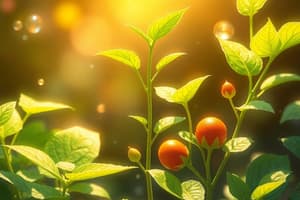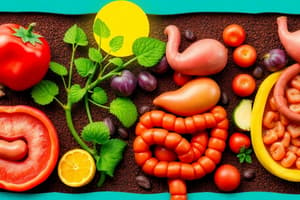Podcast
Questions and Answers
Which tissue is responsible for transporting water and minerals in plants?
Which tissue is responsible for transporting water and minerals in plants?
- Cortex
- Xylem (correct)
- Phloem
- Cambium
What is the primary role of the human circulatory system?
What is the primary role of the human circulatory system?
- Producing hormones
- Transporting substances (correct)
- Digesting food
- Regulating temperature
What is the function of the kidneys in the excretory system?
What is the function of the kidneys in the excretory system?
- Absorb nutrients
- Produce hormones
- Filter blood (correct)
- Regulate body temperature
Which system uses nerve impulses to transmit signals quickly in animals?
Which system uses nerve impulses to transmit signals quickly in animals?
What is phototropism in plants?
What is phototropism in plants?
What role do hormones play in the endocrine system of animals?
What role do hormones play in the endocrine system of animals?
In which way do animals primarily exhibit movement?
In which way do animals primarily exhibit movement?
What is transpiration in plants?
What is transpiration in plants?
What is the overall reaction formula for photosynthesis?
What is the overall reaction formula for photosynthesis?
Which of the following nutrients is NOT essential for plant growth?
Which of the following nutrients is NOT essential for plant growth?
What type of organisms are animals classified as in terms of nutrition?
What type of organisms are animals classified as in terms of nutrition?
What is the role of salivary amylase in the human digestive system?
What is the role of salivary amylase in the human digestive system?
Which statement accurately describes aerobic respiration compared to anaerobic respiration?
Which statement accurately describes aerobic respiration compared to anaerobic respiration?
Which of the following organs is NOT part of the human digestive system?
Which of the following organs is NOT part of the human digestive system?
Which nutrient is primarily responsible for energy storage and insulation in the human body?
Which nutrient is primarily responsible for energy storage and insulation in the human body?
Which of these is NOT a characteristic of photosynthesis?
Which of these is NOT a characteristic of photosynthesis?
Flashcards
What are autotrophs?
What are autotrophs?
Plants make their own food using sunlight, water, and carbon dioxide through photosynthesis.
What is photosynthesis?
What is photosynthesis?
The process where plants convert sunlight, water, and carbon dioxide into glucose and oxygen.
What is chlorophyll?
What is chlorophyll?
A green pigment found in chloroplasts that absorbs sunlight for photosynthesis.
What are heterotrophs?
What are heterotrophs?
Signup and view all the flashcards
What is animal nutrition?
What is animal nutrition?
Signup and view all the flashcards
What are the two types of digestion?
What are the two types of digestion?
Signup and view all the flashcards
What are the main types of nutrients and their functions?
What are the main types of nutrients and their functions?
Signup and view all the flashcards
What is respiration?
What is respiration?
Signup and view all the flashcards
What does xylem transport in plants?
What does xylem transport in plants?
Signup and view all the flashcards
What does phloem transport in plants?
What does phloem transport in plants?
Signup and view all the flashcards
What is transpiration?
What is transpiration?
Signup and view all the flashcards
What is the human circulatory system?
What is the human circulatory system?
Signup and view all the flashcards
What is excretion?
What is excretion?
Signup and view all the flashcards
What is a tropism?
What is a tropism?
Signup and view all the flashcards
How do animals move?
How do animals move?
Signup and view all the flashcards
What is the nervous system?
What is the nervous system?
Signup and view all the flashcards
Study Notes
Nutrition in Plants
- Plants are autotrophs, synthesizing their own food using sunlight, water, and carbon dioxide through photosynthesis.
- Photosynthesis occurs in chloroplasts, containing chlorophyll, a green pigment absorbing sunlight.
- The overall photosynthesis reaction is: 6CO₂ + 6H₂O → C₆H₁₂O₆ + 6O₂ (Carbon dioxide + Water → Glucose + Oxygen).
- Plants require minerals (nitrogen, phosphorus, potassium, magnesium) for growth, absorbed through roots.
Nutrition in Animals
- Animals are heterotrophs, obtaining food from other organisms.
- Animal nutrition involves intake, digestion, absorption, and assimilation of food.
- Animals exhibit diverse feeding habits: herbivores (plant-eaters), carnivores (meat-eaters), and omnivores (eating both).
Human Digestive System
- The human digestive system breaks down food into absorbable molecules.
- Key organs include mouth, esophagus, stomach, small intestine, large intestine, liver, pancreas, and gallbladder.
- Each organ plays a specific digestive role.
- Mechanical digestion physically breaks down food; chemical digestion uses enzymes to break down molecules.
- Salivary amylase initiates carbohydrate digestion in the mouth.
Nutrition in Humans - Importance of Different Nutrients
- Carbohydrates are the body's primary energy source.
- Proteins are vital for growth, repair, and tissue maintenance.
- Lipids (fats) provide insulation and energy storage.
- Vitamins and minerals are essential for metabolic functions.
- Nutrient deficiencies can cause health problems.
- A balanced diet with all nutrients is crucial for health.
Respiration
- Respiration breaks down food molecules, releasing energy as ATP.
- Aerobic respiration needs oxygen; anaerobic respiration doesn't.
- Aerobic respiration is more efficient, producing more ATP.
- The human respiratory system takes in oxygen and expels carbon dioxide.
- Involved organs include the nose, trachea, bronchi, and lungs.
Transportation in Plants
- Plants transport water, minerals, and food through xylem and phloem.
- Xylem carries water and minerals from roots to the plant.
- Phloem transports sugars (made during photosynthesis) from leaves to other parts.
- Transpiration, water loss from leaves through evaporation, is crucial for water transport.
Transportation in Humans
- The human circulatory system transports substances throughout the body.
- This system consists of the heart, blood vessels (arteries, veins, capillaries), and blood.
- Blood carries oxygen, nutrients, hormones, and waste products.
- The heart is a muscular pump circulating blood.
- The circulatory system maintains internal balance (homeostasis).
Excretion in Humans
- Excretion removes metabolic waste from the body.
- The excretory system includes kidneys, ureters, bladder, and urethra.
- Kidneys filter blood, producing urine containing waste.
- Urine is stored in the bladder and eliminated through the urethra.
- Excretion maintains a healthy internal environment.
Control and Coordination in Animals
- Control and coordination are crucial for homeostasis and responding to stimuli.
- The nervous and endocrine systems play key roles.
- The nervous system uses nerve impulses for quick signals.
- The endocrine system uses hormones for regulatory functions.
- Coordination handles internal and external stimuli.
Control and Coordination in Plants
- Plants display growth responses (tropisms).
- Phototropism is the response to light.
- Geotropism is the response to gravity.
- Plants react to touch, water, and other stimuli.
- Plants lack nervous tissue and hormones as in animals.
- Plant growth regulators, such as auxins, coordinate responses.
Movement in Plants and Animals
- Plants have limited movement, primarily growth responses.
- Animals have diverse movements: walking, running, flying, swimming.
- Muscles and skeletons enable animal movement.
- Coordination between the nervous system and muscles is essential for movement.
- Skeletal systems provide support and protection.
Studying That Suits You
Use AI to generate personalized quizzes and flashcards to suit your learning preferences.




